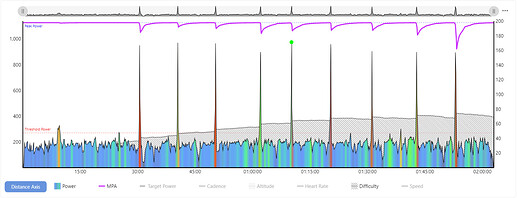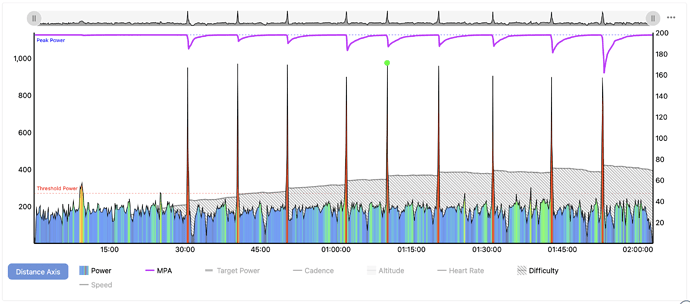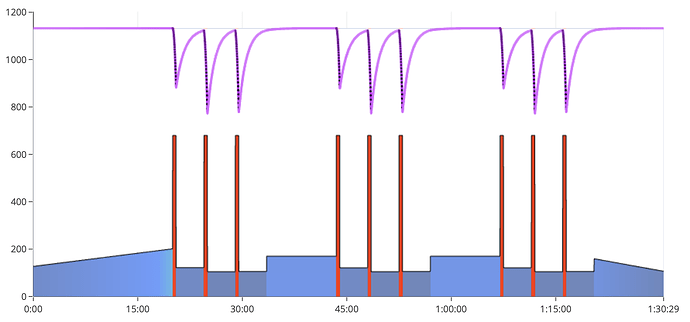Could anyone please point me to an article that shows where (presumably as a % of TP) the High and Peak systems kick in? I’ve seen the graph that shows three lines comprising which systems are contributing what %, but it was with reference to power with no reference as to the TP of said theoretical rider.
Hi Rob,
Best not to use %TP for this, since %TP doesn’t scale well across athletes at relatively high power outputs. The absolute TP of the reference rider is irrelevant, since all athletes have the same energy systems & the strain they receive will be equal when riding at the same relative intensity. IOW, if 2 athletes with vastly different signatures are both riding at their unique 2min power, they receive the same strain distribution, even if one athlete’s 2min power is several hundred watts greater than the other’s.
As we do with our workouts, it’s better to define/prescribe these types of intervals using your Mean Max Power (MMP), derived from your fitness signature & power-duration curve.
In general, to best work the HIE/PP systems, you want to use very short, very hard intervals. HIE will be the largest contributing system for intensities between your ~20s and 3 min power. And Peak Power will be the biggest contributor only for sprints at/above your 20s power. If you’re sprinting several hundred watts below your PP (even if you’re close to your MPA), you’re not effectively training your Peak Power system.
I actually just did an endurance ride yesterday and mixed in very short (<10s) all-out sprints to keep working my Peak Power system. The goal is to keep the sprints very hard & very short. If done correctly, you should end up with a focus under 3:00 and polar specificity. In my example here, the ride was a Polar Pursuiter Focus ride (2:52 Focus).
A workout that really works the HIE system would be anything that has short intervals at high power outputs. Ideally, the resulting Focus would be <5min. Again, the key to these efforts is typically relatively short & relatively hard. A good example would be the SMART - Born For Greatness series of workouts:
Anything less than these intensities (even VO2max) does still put strain on the HIE system, but starts placing more strain on your low-intensity (aerobic) system. For example, Ronnestad is a classic Xert workout, but I usually see people end with a focus duration above 5 minutes, indicating it’s a good ‘VO2max’ workout, but isn’t the most optimal for increasing HIE. But to put things in context, Ronnestands would still be far more beneficial for increasing HIE compared to something like 4x8’s.
Hope this helps!
Hi Scott, thank you for your usual insightful response! - very helpful.
My intention was to be able to feed in a certain “dose” of HTL on my outdoor rides to keep my HTL trending upwards. I don’t use 20s power too often unless there’s an inadvertent smash-fest going on, so I will add in a few intervals as you’ve suggested and see what the effect is. Would you recommend front-loading these into the outdoor rides so as to hit them whilst fresh, or doesn’t it really matter as long as you hit the target? (I’m thinking maybe 8 reps of 10-15s at 20s max-power)
I usually see these sorts of all-out intervals prescribed during/along with a generally easy workload, so should generally matter when you do them, as long as they are maximal. As I alluded to previously, you can only place strain on these systems by riding sufficiently hard. E.g. if your MPA starts at 1000 W, you shouldn’t be trying these sprints when your MPA is down to 600 W.
This is one of many useful scenarios where MPA can be utilized in real-time to train effectively - here’s an example of a ‘zone 2’ ride I did while sprinkling in an all-out 10s sprint every ~10 min or so, making sure MPA had almost completely recovered before doing the next sprint:
And here’s a workout I designed based on a study from Taylor, et al. in Ronnestad’s research group. The goal of this workout is to get a good low intensity training (LIT) ride in, but to add in 3 sets of 30s all-out sprints with 4 min of rest between efforts and 10min recovery between sets. The 4 min recoveries are SMART, so they’ll adjust up/down depending on how you do during the sprint effort:
I’ve also heard recommendations to do these efforts at the end of a long ride to avoid any interference with ‘fat-burning’ during your endurance ride. But I suspect if your sprint efforts are kept short and supramaximal/all-out, then it’s mostly a phosphocreatine effort anyways and shouldn’t push you much into anaerobic glycolysis (unless the sprints start getting too long, like 20+ sec).
Hopefully the examples give you some ideas… it might be time to move that workout into the main Xert workout library. ![]()



